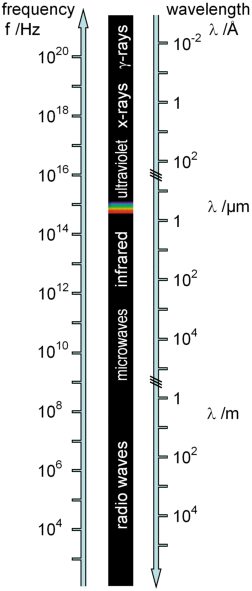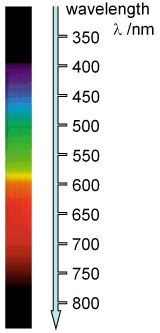1. Light and Radiation
The radiation spectrum (1/3)
Wavelength and frequency are parameters which are commonly used to characterise the spectral range of light and radiation. The range of radiation wavelengths and frequencies covers many orders of magnitude, from the radio waves having wavelengths of kilometres to metres up to the x-rays and γ-rays (or: gamma rays) which have wavelengths as small as an atom or even less than an atom.
Almost hidden in the radiation spectrum in the left column, visible light takes up only a very small portion at around one micrometre (μm) wavelength, bounded by radiation which is invisible to the eye. A closer look at this visible part is shown below.
In these graphs, wavelengths are given in different units:
- centimetres (cm) and metres (m) are used with microwaves and radio waves
- micrometres (μm) are used with infrared radiation, and it is 1 μm=10-6 m
- nanometres (nm) are used to characterise visible wavelengths, with 1 nm=10-9 m, and it is 1 μm=1000 nm
- the symbol Å stands for the Ångström unit, with 1 Å=10-10 m Ångströms are used with x- and γ rays, and it is 1 nm=10 Å.
Frequencies are given in
- terahertz: 1 THz=1012 Hz
- gigahertz: 1 GHz=109 Hz
- megahertz: 1 MHz=106 Hz
- kilohertz: 1kHz=103 Hz.
Radio waves have frequencies of around 100 kHz to 100 MHz, microwaves of 1 to 100 GHz, typically. Visible light has frequencies around 500 THz.


